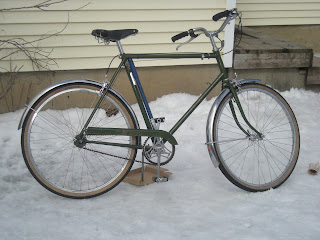I had a turkey knock me off my bike last night riding through the UW Arboretum.
The immediate cause was a young wild turkey in the road, but I was prepared to handle that. I ride a lot in the Arb, and know about the flocks of wild turkeys. I have seen as many as a dozen at a time, and have never before gotten mixed up with them.
No, the turkey who took me down was one of those guys who buys an expensive bike, thinks he knows how to ride and gets himself and other people in trouble.
About a mile before, the wheeled turkey was overtaking a couple who were riding slowly side-by-side. I was coming up faster than everybody, but slowed down to see what was going to happen. Turkey, without looking back, sudden swung wide of the couple, crossed the double yellow into the oncoming lane and went around the couple without saying a word. I passed them and said, "good evening," and they continued on their way, riding in a straight, predictable line. There was plenty of room for all of us in the road.
Turkey, again without looking back, swung wildly back into the lane, which I kind of figured he would do, so I had hung back. I watched him for a few yards, and he was weaving back and forth across the road, not holding a line, but also not getting too close to the lane marker. When he weaved toward the curb, I accelerated past him, leaving about a foot and a half between us, but not saying anything. He looked over as I past and said "Jesus Christ." OK, I should have said, "On your left," but I figured that would have been his cue to swerve left, so I just went to the far left edge of the lane and got around him as quickly as I could. This was on an easy rise, but he fell quickly behind.
Down the treed hill just before the houses, I noticed the rain had washed a lot of sand into the road, so I did not go full speed. As I went up the first rise in the housing section, it looked like Turkey was riding fast and trying to catch me.
OK, the road gets safer when it flattens out and straightens out, and maybe I should explain myself, I thought.
Once I talk to him, I can soft pedal on the flats and let him ride away.
I did not get that chance, though. In the road ahead of me, there were three young wild turkeys spread across the road. All of them were facing my left, and seemed to be moving that way, so I went to the right edge of the road and slowed down. The wild turkeys ambled left, and it looked like we were all going to avoid mixing.
But here comes Two-wheel Turkey!
Coming up way too fast, he must be sure he is going to catch me and pass me. He splits the flock, with one turkey cut off from the others by his huge buzzing interloper (what the turkey sees when he sees "bike"), and that panicked bird bolts, taking my front wheel out from under me.
[Insert your favorite expletives here, with a couple of exclamation points.]
Turkey turned around and came back, asking if I was OK, as I bled from elbow and knee.
"I'll be OK." I actually tried to tell him about his passing dangerously earlier, but he was so sure he was right, I just shut up. I found his intellect to be about equal to a smart, 9-month-old dog. Eager to please but clueless.
"Do you want me to ride with you a little ways to see if you are OK?"
"No, I am fine."
But if you keep talking at me without acknowledging what a mess you created, I'm going to explode, I thought. He had the sense to go on about his way, and I rode back home through the Arb.
Inspection showed a broken helmet, so after I cleaned up the road rash, I went to the emergency room, where I spent almost four hours to find out that I had no brain damage and I had done a reasonable job cleaning up the road rash. Bike is a little scuffed up, and should get new brake lever hoods, but they can wait. Helmet did its job, so needs to be retired.
All told, a very minor accident. But it should not have happened. Anybody who has ever watch a flock of turkeys could have known, SHOULD have known that you don't split up the flock, or they scatter and panic. If Two-wheel Turkey had just slowed down for a minute and followed me past them, nobody would have gotten hurt. And Turkey might be known by some other name.







